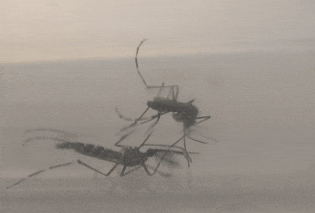
Large male mosquitoes unluckier in love
Words and images: Perran Ross
Large male mosquitoes may have more trouble than smaller males in finding a partner. In a new study, we find that small female mosquitoes tend to avoid larger males, preferring to mate with smaller ones. In this study, now available as a pre-print on bioRxiv, we performed laboratory experiments to investigate the effect of male and female body size on mating success.
In these experiments we generated large and small mosquitoes by changing the amount of food provided before they reached adulthood. Large mosquitoes were given unlimited access to food during the larval stage, while small mosquitoes were starved just before they reached the pupal stage. We then put a mix of large and small males into cages with female mosquitoes of different sizes, and evaluated their mating success.
We found that when females were large, large males and small males were equally successful at mating. But when we tested small females, small males outcompeted the large males. In nature, where mosquitoes are found at a wide range of sizes, small males might have the edge.
Our results could be important for modified mosquito releases that are now happening around the world. Some of these programs aim to suppress natural mosquito populations by releasing males that can essentially sterilise the wild females. These mosquitoes are usually reared in the laboratory where they are fed optimally to produce adults of a large size. But if the males are too large, they may have trouble mating with the smaller females in the population.
Mosquitoes normally mate in flight, but when there’s a mismatch in size, sex can be awkward. In preliminary observations, we find that large males cannot mate easily with small females in flight.
A large male mosquito struggles to mate with a small female
Instead, they tend to mate on the bottom of the cage, and with greater difficulty than usual. Our experiments were conducted in the laboratory and in quite small cages, so it would be interesting to see how our observations translate to the field. But if small males are indeed more successful under real-world conditions, then it could be worthwhile to produce mosquitoes of a range of sizes in release programs, rather than making them as large as possible. It will also be important to understand why this difference in mating success exists. If a proportion of the wild population cannot mate with laboratory-reared males, it will make it difficult to eliminate populations with modified mosquito releases.
